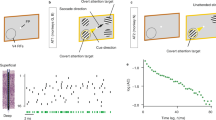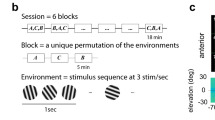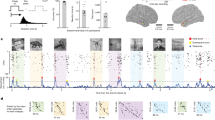Abstract
Attention improves the encoding of visual stimuli. One mechanism that is implicated in facilitating sensory encoding is the firing of action potentials in bursts. We tested the hypothesis that when spatial attention is directed to a stimulus, this causes an increase in burst firing to the attended stimulus. To the contrary, we found an attention-dependent reduction in 'burstiness' among putative pyramidal neurons in macaque area V4. We accounted for this using a conductance-based Hodgkin-Huxley style model in which attentional modulation stems from scaling excitation and inhibition. The model exhibited attention-dependent increases in firing rate and made the surprising and correct prediction that when attention is directed into a neuron's receptive field, this reduces action-potential height. The model thus provided a unified explanation for three distinct forms of attentional modulation, two of them previously undescribed, and implicates scaling of the responses of excitatory and inhibitory input populations in mediating attention.
This is a preview of subscription content, access via your institution
Access options
Subscription info for Japanese customers
We have a dedicated website for our Japanese customers. Please go to natureasia.com to subscribe to this journal.
Buy this article
- Purchase on SpringerLink
- Instant access to full article PDF
Prices may be subject to local taxes which are calculated during checkout




Similar content being viewed by others
Change history
17 July 2013
In the version of this article initially published online, burstiness was defined on p. 1 as the prosperity of neurons to fire rather than the propensity, and model neuron firing rates were given on p. 3 in nHz rather than Hz. The errors have been corrected for the print, PDF and HTML versions of this article.
References
Krahe, R. & Gabbiani, F. Burst firing in sensory systems. Nat. Rev. Neurosci. 5, 13–23 (2004).
Sherman, S.M. Tonic and burst firing: dual modes of thalamocortical relay. Trends Neurosci. 24, 122–126 (2001).
Cattaneo, A., Maffei, L. & Morrone, C. Patterns in the discharge of simple and complex visual cortical cells. Proc. R. Soc. Lond. B Biol. Sci. 212, 279–297 (1981).
Samonds, J.M. & Bonds, A.B. From another angle: differences in cortical coding between fine and coarse discrimination of orientation. J. Neurophysiol. 91, 1193–1202 (2004).
Shih, J.Y., Atencio, C.A. & Schreiner, C.E. Improved stimulus representation by short interspike intervals in primary auditory cortex. J. Neurophysiol. 105, 1908–1917 (2011).
Reich, D.S., Mechler, F., Purpura, K.P. & Victor, J.D. Interspike intervals, receptive fields, and information encoding in primary visual cortex. J. Neurosci. 20, 1964–1974 (2000).
Izhikevich, E.M., Desai, N.S., Walcott, E.C. & Hoppensteadt, F.C. Bursts as a unit of neural information: selective communication via resonance. Trends Neurosci. 26, 161–167 (2003).
Caporale, N. & Dan, Y. Spike timing-dependent plasticity: a Hebbian learning rule. Annu. Rev. Neurosci. 31, 25–46 (2008).
Sjöström, P.J., Rancz, E.A., Roth, A. & Häusser, M. Dendritic excitability and synaptic plasticity. Physiol. Rev. 88, 769–840 (2008).
De Weerd, P., Peralta, M.R. III, Desimone, R. & Ungerleider, L.G. Loss of attentional stimulus selection after extrastriate cortical lesions in macaques. Nat. Neurosci. 2, 753–758 (1999).
Reynolds, J.H. & Heeger, D.J. The normalization model of attention. Neuron 61, 168–185 (2009).
Mitchell, J.F., Sundberg, K.A. & Reynolds, J.H. Differential attention-dependent response modulation across cell classes in macaque visual area V4. Neuron 55, 131–141 (2007).
Brumberg, J.C., Nowak, L.G. & McCormick, D.A. Ionic mechanisms underlying repetitive high-frequency burst firing in supragranular cortical neurons. J. Neurosci. 20, 4829–4843 (2000).
Nowak, L.G., Azouz, R., Sanchez-Vives, M.V., Gray, C.M. & McCormick, D.A. Electrophysiological classes of cat primary visual cortical neurons in vivo as revealed by quantitative analyses. J. Neurophysiol. 89, 1541–1566 (2003).
Vigneswaran, G., Kraskov, A. & Lemon, R.N. Large identified pyramidal cells in macaque motor and premotor cortex exhibit “thin spikes”: implications for cell type classification. J. Neurosci. 31, 14235–14242 (2011).
Anderson, E.B., Mitchell, J.F. & Reynolds, J.H. Attentional modulation of firing rate varies with burstiness across putative pyramidal neurons in macaque visual Area V4. J. Neurosci. 31, 10983–10992 (2011).
Mitchell, J.F., Sundberg, K.A. & Reynolds, J.H. Spatial attention decorrelates intrinsic activity fluctuations in macaque area V4. Neuron 63, 879–888 (2009).
Arieli, A., Sterkin, A., Grinvald, A. & Aertsen, A. Dynamics of ongoing activity: explanation of the large variability in evoked cortical responses. Science 273, 1868–1871 (1996).
Smith, M.A. & Kohn, A. Spatial and temporal scales of neuronal correlation in primary visual cortex. J. Neurosci. 28, 12591–12603 (2008).
Wang, Z. & McCormick, D.A. Control of firing mode of corticotectal and corticopontine layer V burst-generating neurons by norepinephrine, acetylcholine, and 1S,3R-ACPD. J. Neurosci. 13, 2199–2216 (1993).
Steriade, M., Timofeev, I. & Grenier, F. Natural waking and sleep states: a view from inside neocortical neurons. J. Neurophysiol. 85, 1969–1985 (2001).
Golomb, D., Cuiyong, Y. & Yaari, Y. Contribution of persistent Na+ current and M-type K+ current to somatic bursting in CA1 pyramidal cells: combined experimental and modeling study. J. Neurophysiol. 96, 1912–1926 (2006).
Destexhe, A., Rudolph, M., Fellous, J.M. & Sejnowski, T.J. Fluctuating synaptic conductances recreate in vivo-like activity in neocortical neurons. Neuroscience 107, 13–24 (2001).
Reynolds, J.H., Chelazzi, L. & Desimone, R. Competitive Mechanisms Subserve Attention in Macaque Areas V2 and V4. J. Neurosci. 19, 1736–1753 (1999).
Yue, C. & Yaari, Y. KCNQ/M channels control spike afterdepolarization and burst generation in hippocampal neurons. J. Neurosci. 24, 4614–4624 (2004).
Colbert, C.M., Magee, J.C., Hoffman, D.A. & Johnston, D. Slow recovery from inactivation of Na+ channels underlies the activity-dependent attenuation of dendritic action potentials in hippocampal CA1 pyramidal neurons. J. Neurosci. 17, 6512–6521 (1997).
Jung, H.-Y., Mickus, T. & Spruston, N. Prolonged sodium channel inactivation contributes to dendritic action potential attenuation in hippocampal pyramidal neurons. J. Neurosci. 17, 6639–6646 (1997).
Martina, M. & Jonas, P. Functional differences in Na+ channel gating between fast-spiking interneurones and principal neurones of rat hippocampus. J. Physiol. (Lond.) 505, 593–603 (1997).
Bean, B.P. The action potential in mammalian central neurons. Nat. Rev. Neurosci. 8, 451–465 (2007).
McCormick, D.A., Connors, B.W., Lighthall, J.W. & Prince, D.A. Comparative electrophysiology of pyramidal and sparsely spiny neurons of the neocortex. J. Neurophysiol. 54, 782–806 (1985).
Gonzàlez-Burgos, G., Krimer, L.S., Povysheva, N.V., Barrionuevo, G. & Lewis, D.A. Functional properties of fast spiking interneurons and their synaptic connections with pyramidal cells in primate dorsolateral prefrontal cortex. J. Neurophysiol. 93, 942–953 (2005).
Carter, B.C. & Bean, B.P. Sodium entry during action potentials of mammalian neurons: incomplete inactivation and reduced metabolic efficiency in fast spiking neurons. Neuron 64, 898–909 (2009).
de Polavieja, G.G., Harsch, A., Kleppe, I., Robinson, H.P.C. & Juusola, M. Stimulus history reliably shapes action potential waveforms of cortical neurons. J. Neurosci. 25, 5657–5665 (2005).
McAdams, C.J. & Maunsell, J.H. Effects of attention on orientation tuning functions of single neurons in macaque cortical area V4. J. Neurosci. 19, 431–441 (1999).
Harris, K.D. & Thiele, A. Cortical state and attention. Nat. Rev. Neurosci. 12, 509–523 (2011).
Noudoost, B., Chang, M.H., Steinmetz, N.A. & Moore, T. Top-down control of visual attention. Curr. Opin. Neurobiol. 20, 183–190 (2010).
Pinsky, P.F. & Rinzel, J. Intrinsic and network rhythmogenesis in a reduced traub model for CA3 neurons. J. Comp. Neurosci. 1, 39–60 (1994).
Mainen, Z.F. & Sejnowski, T.J. Influence of dendritic structure on firing pattern in model neocortical neurons. Nature 382, 363–366 (1996).
Kepecs, A. & Wang, X.-J. Analysis of complex bursting in cortical pyramidal neuron models. Neurocomputing 32, 181–187 (2000).
Matsumura, M., Chen, D., Sawaguchi, T., Kubota, K. & Fetz, E.E. Synaptic interactions between primate precentral cortex neurons revealed by spike-triggered averaging of intracellular membrane potentials in vivo. J. Neurosci. 16, 7757–7767 (1996).
Anderson, J.S., Carandini, M. & Ferster, X. Orientation tuning of input conductance, excitation and inhibition in cat primary visual cortex. J. Neurophysiol. 84, 909–926 (2000).
Gold, C., Henze, D.A., Koch, C. & Buzsáki, G. On the origin of the extracellular action potential waveform: a modeling study. J. Neurophysiol. 95, 3113–3128 (2006).
Henze, D.A. et al. Intracellular features predicted by extracellular recordings in the hippocampus in vivo. J. Neurophysiol. 84, 390–400 (2000).
Harris, K.D. et al. Temporal interaction between single spikes and complex spike bursts in hippocampal pyramidal cells. Neuron 32, 141–149 (2001).
Quirk, M.C., Blum, K.E. & Wilson, M.A. Experience-dependent changes in extracellular spike amplitude may reflect regulation of dendritic action potential back-propagation in rat hippocampal pyramidal cells. J. Neurosci. 21, 240–248 (2001).
Ringach, D.L., Hawken, M.J. & Shapley, R. Dynamics of orientation tuning in macaque primary visual cortex. Nature 387, 281–284 (1997).
Pylyshyn, Z.W. & Storm, R.W. Tracking multiple independent targets: evidence for a parallel tracking mechanism. Spat. Vis. 3, 179–197 (1988).
Cavanagh, P. & Alvarez, G.A. Tracking multiple targets with multifocal attention. Trends Cogn. Sci. 9, 349–354 (2005).
Barth, P. et al. Characterization of neocortical principal cells and interneurons by network interactions and extracellular features. J. Neurophysiol. 92, 600–608 (2004).
Aracri, P. et al. Layer-specific properties of the persistent sodium current in sensorimotor cortex. J. Neurophysiol. 95, 3460–3468 (2006).
Acknowledgements
This work was supported in part by US National Eye Institute grant EY13802 (J.F.M. and J.H.R.) and The Gatsby Charitable Foundation (E.B.A. and J.H.R.). We thank K. Sundberg for help in data collection, and C. Williams and J. Reyes for help with animal care.
Author information
Authors and Affiliations
Contributions
E.B.A. analyzed the data and built the model. J.F.M. collected most of the physiology data and contributed to the burst-reduction analyses. E.B.A., J.F.M. and J.H.R. wrote the manuscript.
Corresponding authors
Ethics declarations
Competing interests
The authors declare no competing financial interests.
Supplementary information
Supplementary Figures and Text
Supplementary Figures 1–4 (PDF 630 kb)
Rights and permissions
About this article
Cite this article
Anderson, E., Mitchell, J. & Reynolds, J. Attention-dependent reductions in burstiness and action-potential height in macaque area V4. Nat Neurosci 16, 1125–1131 (2013). https://doi.org/10.1038/nn.3463
Received:
Accepted:
Published:
Issue Date:
DOI: https://doi.org/10.1038/nn.3463
This article is cited by
-
Neural burst codes disguised as rate codes
Scientific Reports (2021)
-
Neural mechanism of visual information degradation from retina to V1 area
Cognitive Neurodynamics (2021)
-
A cortical model with multi-layers to study visual attentional modulation of neurons at the synaptic level
Cognitive Neurodynamics (2019)
-
Sensory coding accuracy and perceptual performance are improved during the desynchronized cortical state
Nature Communications (2017)



